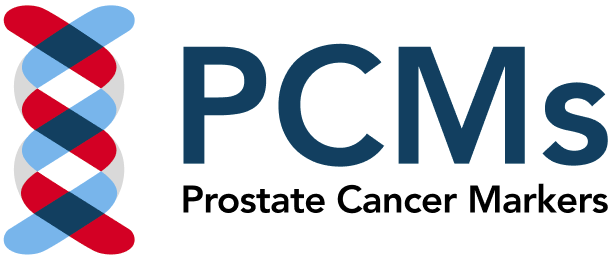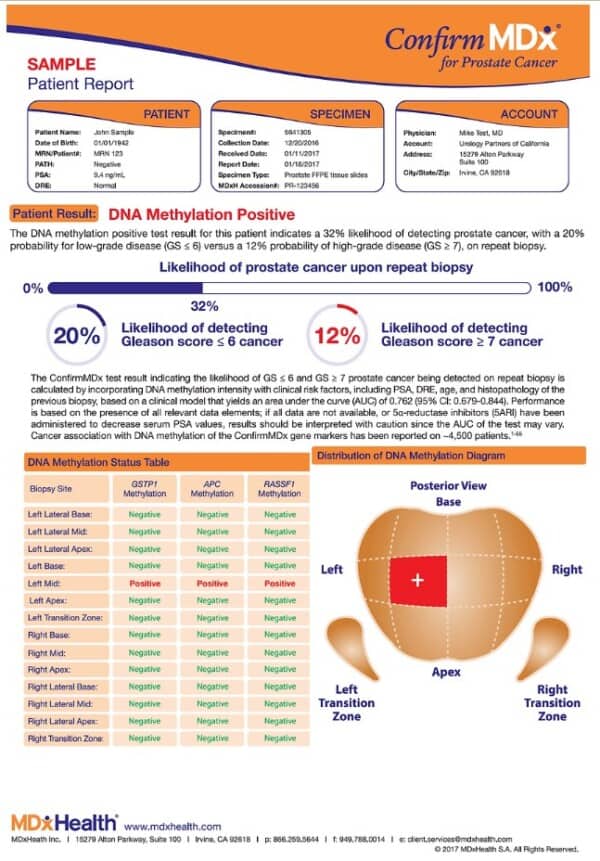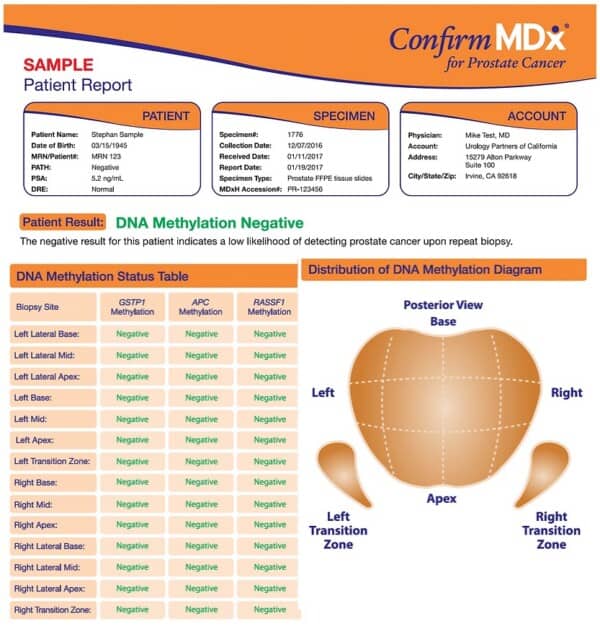What do my Confirm MDx Results mean?
ConfirmMDx was designed to be used in patients where there is a suspicion of prostate cancer but, despite undergoing TRUS biopsy, have not been appropriately diagnosed (due to the random nature of the TRUS biopsy). This problem becomes further problematic by the fact that prostate cancer is often a disease that occurs in more than one area of the prostate.
Individuals presenting with risk factors, including abnormal DRE, elevated/rising prostate specific antigen (PSA), elevated/high risk biomarkers such as SelectMDx, in combination with one or multiple negative/atypical prostate biopsies may benefit from a ConfirmMDx test. By testing for the presence of hypermethylation (which is when certain molecules bind to areas of the genetic code (DNA) that have been shown to be precursors to initiating/promoting prostate cancer) of 3 biomarkers from your benign/atypical prostate tissue, your health care provider may be able to determine which area(s) of the prostate may be “hot spots” for prostate cancer, subsequently targeting these zone(s) of suspicion at the time of repeat biopsy.
Positive Test Result
Below you will find an example of a positive test result, and further explanation of key areas of the report to learn what each section means.
DNA Methylation Result:
Statistical Section:
This section describes the statistical properties and how the ConfirmMDx test was validated. Basically, if the test has excellent ability to predict if there is cancer in the area based on hypermethylation, it will have an AUC of 1. If it has a poor ability to predict if there is cancer in the area based on hypermethylation, it would have a AUC of less than or equal to .50. The ConfirmMDx test has an AUC of .76, meaning it has a good predictive ability to predict if there is cancer in an area based on the hypermethylated tissue. The 95% confidence interval of .67-.84 shows the AUC range where 95% of this population studied fell in to (with the lowest of 64% accuracy to the highest of 84% accuracy).
DNA Status Table:
DNA Methylation Result: This section describes whether your ConfirmMDx test was positive for methylation. At the top of the table, you will notice 3 different methylation sites, GSTP1, APC, and RASSF1. Each of these genomic markers have been found to have the following association with prostate cancer.
GSTP1: Has been shown to be strongly correlated with prostate cancer. This biomarker, when hypermethylated, loses its ability to detoxify molecules which can damage your genetic code (DNA). This has been shown in research to cause an inflammatory response and potentially create lesions which are believed to be precursors to prostate cancer.
APC: Has been shown in research to be a gene that suppresses the cell from becoming cancerous (known as a tumor suppressor gene). When molecules bind to your genetic code (DNA), it can create errors in that code which can turn the APC gene off. When this occurs, the silencing of APC can lead to other important cell pathways to be turned off. This silencing of APC has been shown to be present in populations of patients with prostate cancer.
RASSF1: Has been shown in research to be a gene that suppress the cell from becoming cancerous (known as a tumor suppressor gene). It is believed that hypermethylation of this biomarker deactivates RASSF1s ability to stop normal cell division, thereby opening a pathway for the cell to become malignant.
Overall, if your benign or atypical prostate tissue has signs of methylation, it may indicate that there is a prostate cancer very close by. This phenomenon is known as the “halo effect,” and has been shown in research to be identified by the ConfirmMDx test. Because of this, the ConfirmMDx test, in combination with your doctor’s guidance, may be useful in understanding which area(s) of your prostate may need to be targeted upon re-biopsy.
Distribution of DNA Methylation Diagram:
This section describes where the positive area or areas of methylation were found within your prostate. The base (“back”) of the prostate is located closest to the bladder, while the apex (“front”) of the prostate is where the penile urethra begins (tube that carries urine/semen).
Negative Test Result
Below you will find an example of a negative test result, and further explanation of key areas of the report to learn what each section means.
DNA Methylation Result:
This section describes that your ConfirmMDx test was negative for methylation.
DNA Methylation Status Table:
GSTP1: Has been shown to be strongly correlated with prostate cancer. This biomarker, when hypermethylated, loses its ability to detoxify molecules which can damage your genetic code (DNA). This has been shown in research to cause an inflammatory response and potentially create lesions which are believed to be precursors to prostate cancer.
APC: Has been shown in research to be a gene that suppresses the cell from becoming cancerous (known as a tumor suppressor gene). When molecules bind to your genetic code (DNA), it can create errors in that code which can turn the APC gene off. When this occurs, the silencing of APC can lead to other important cell pathways to be turned off. This silencing of APC has been shown to be present in populations of patients with prostate cancer.
RASSF1: Has been shown in research to be a gene that suppress the cell from becoming cancerous (known as a tumor suppressor gene). It is believed that hypermethylation of this biomarker deactivates RASSF1s ability to stop normal cell division, thereby opening a pathway for the cell to become malignant.
Overall, your benign or atypical prostate tissue did not show signs of methylation, it may indicates a low probability that there is a prostate cancer very close by.
Distribution of DNA Methylation Diagram:
This section describes that no areas of methylation were found within your prostate. The base (“back”) of the prostate is located closest to the bladder, while the apex (“front”) of the prostate is where the penile urethra begins (tube that carries urine/semen).


